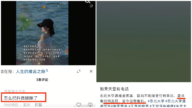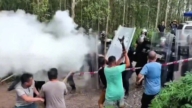【新唐人2011年9月29日讯】“李双江之子打人”事件,连累到远在山西的特种车牌阶层,成为了全国舆论的众矢之的,这恐怕是肇事者自己也没有想到的。山西省一度号称是国内整治特种车牌的典范区域,但如今却越来越力不从心,业内人士透露:“整顿更像是一个障眼法,谁会主动革掉自己的特权?”
“晋O-00888”的奥迪车牌,近期成为国内最有知名度的车牌。驾驶奥迪的苏楠帮朋友李天一殴打一对夫妇后,他们的车牌被人记住,眼尖的网友发现,“晋O”的牌照是山西省公安系统的专用号段,也就是说,只有当地公安系统的公务用车才能悬挂这类车牌。
苏楠的牌照被曝光不久,迅速被认定为伪造,他的父亲苏文斌因此被拘留。苏文斌在北京拥有一家汽贸公司,据说他与山西省公安厅副厅长、太原市公安局局长苏浩“关系密切”。不过,一个商人为什么敢伪造特种车牌?十几岁的少年为什么敢打人还大喊“谁敢打110”?
“晋O”牌是山西省公安系统专段民用号牌,出现于1995年,当时为了方便公安办案,规定“O”牌车在紧急执行公务时,可闯红灯、闯电子警察、逆行,并有免缴过路费、过桥费,停靠不受制约等权力,被民间一时称为“特权车”。因此,政府单位先后都从管车牌的公安机关获得这类车牌。在山西和其他一些省份,甚至还有将“O”牌车批给关系户的,而这些车主多为高官的亲友和富商。
“O”牌车闯红灯、压黄线、逆行、乱停乱放、超速行驶等现象屡见不鲜,引起民众极大反感。2004年,山西省对“晋O”车牌进行改挂工作,只有公安机关可以保留“晋O”牌照的公务用车。这次调整中,山西共有两千多辆车的“晋O”车牌被换下。
不过事实上,整治并没能遏制特种车牌的蔓延。山西省委省政府及省属单位的公车在换下“晋O”车牌后,一律换上了“晋AV”的牌照。另外,例如“晋AG6”,在2009年之前原本是高官家属和关系户的专属号段。但随着街面上挂“晋AG6”牌照的车辆违章剧增,以至于民间开始有人上访。去年(2010年),迫于众怒,太原市交警支队就将“晋AG6”号段车牌拿下,换上了新的“晋AHH”。
《南方周末》报导说,给谁发什么样的牌照,这些牌照有怎样的权力?依据的都是“潜规则”的运作。原平遥县交警部门官员王强表示,上溯到2007年,当地每个月接待“晋AV”的特种车牌超过70辆,他说“遇到违章我们也只能敬礼”。
山西省交管部门近期低调召开会议,研究省内特种车牌问题。《南方周末》引用王强的话说:“现在正在进行自查自纠的阶段,估计过几天搞个验收就过去了,谁会主动革掉自己的特权?”
中国“特权车”横行也引起海外媒体的注意,《德国之声》27号发表 “‘特权车’德国有没有? ” 报导,内容指出,德国的公务车制度相当严格,受到全民的监督,警察没有权利私自滥用公务用车,而且在德国,最严格遵守交通规则的就是警车。
新唐人记者尚燕、王明宇综合报导。
The Unspoken Rules of Privileged Vehicles
Anchor:"Since news broke out about Li Shuangjiang’s son
attacking the driver and passenger with whom
he had a traffic disagreement, owners of specialty
license plates in as far as Shanxi province have
become the target of national criticism. This is
something the perpetrators might not have considered.
Shanxi was once known as the domestic model in
regulating specialty license plates.
However, it’s become increasingly powerless. An insider
expressed, “The regulation is more like a deceptive tactic.
Who’s going to voluntarily remove their own privilege?"
Text: “The license plate number “Jin O-00888″ on
an Audi recently became the most well-known license plate in mainland China.
The driver, Su Nan, helped his friend Li Tianyi attack
a husband and wife.
Passersby remembered his license plate.
Sharp-eyed netizens found that the license plate “Jin O"
series belongs to a public security organization of Shanxi,
which means only official vehicles of the local public
security system will carry a license plate
with this designated number.
After Su Nan’s license plate was exposed,
it was quickly identified as a fake.
His father, Su Wenbin was therefore detained.
Su Wenbin, owner of an automobile company in Beijing,
is said to be friends with Su Hao, the Public Security
Bureau Deputy Director of Shanxi Province
and Public Security Bureau Director of Taiyuan City.
However, why would a businessman dare to forfeit
a specialty plate and why would a teenage boy dare to yell,
“Who dares to call 110?” after he attacked people?
“Jin O" series is a specialty plate number for civilians
within the public security system in Shanxi.
It appeared in 1995 for the convenience of handling cases.
It was regulated that vehicles with the “O” plate,
while carrying out official emergency duties, may run a
red light, and ignore police monitoring system, go in the
opposite direction of traffic, is exempt from tolls and parking,
and enjoys other special treatment.
Vehicles carrying this plate were once called
a privileged vehicle.
Therefore, local government agencies have all obtained
license plate numbers in this series.
In Shanxi and several other provinces, the “O" series plate
was also granted to people who are mostly family
members of high-ranking officials and wealthy businessmen.
The “O" plate owners caused great public resentment
due to frequent violation of traffic rules such as running
red lights, pressing the yellow line, driving the opposite
direction, parking and stopping whenever desired, and speeding.
In 2004, Shanxi Province replaced the plates and
only allowed the public security organization official vehicles to carry such a plate.
There were more than 2000 plates with
Jin O series replaced.
In reality, however, no regulations of special license plates
have contained the spread of specialty plates.
All the buses of Shanxi provincial government and
provincial units replaced Jin O series plates with Jin AV plates.
In addition, take Jin AG6 series plate as an example;
it was designated for families and relatives of
high-ranking officials prior to 2009.
With the increasing traffic violations from Jin AG6 owners,
people started petitioning against such incidents.
Forced by public outrage, the traffic police branch in
Taiyuan City replaced Jin AG6 plates with Jin AHH plates in 2010.
“Southern Weekend" reported that, there are hidden rules
that regulate who are issued what type of license plate
and the kind of authority that comes along with the plate.
Wang Qiang, a former traffic police officer of Pingyao
County, indicated that back in 2007, the local station
monthly accepted more than 70 vehicles with specialty plate such as Jin AV.
He said, “We could only salute when there’s traffic violation."
Recently, the traffic control department of Shanxi
Province quietly held a meeting to address the specialty license plate issue within the province.
Southern Weekend quoted Wang Qiang,
‘It is now the stage of self-correction.
In a few days the inspection will have passed.
Who’s going to voluntarily remove their own privilege?’"
The rampant privileged vehicles in China have also
attracted the attention of overseas media.
Deutsche Welle issued an article titled,
“Does Germany Have Privileged Vehicles?” on the 27th.
It pointed out that Germany’s official vehicle system is
quite strict, under the supervision of the people.
The police have no right to abuse the authority of
utilizing official vehicles.
In Germany, police vehicles are the ones that
most strictly comply with traffic rules.
NTD reporters Shun Yan and Wang Mingyu.





























